Events
Former Disney CEO Ron Miller recalls his own “TRON” legacy
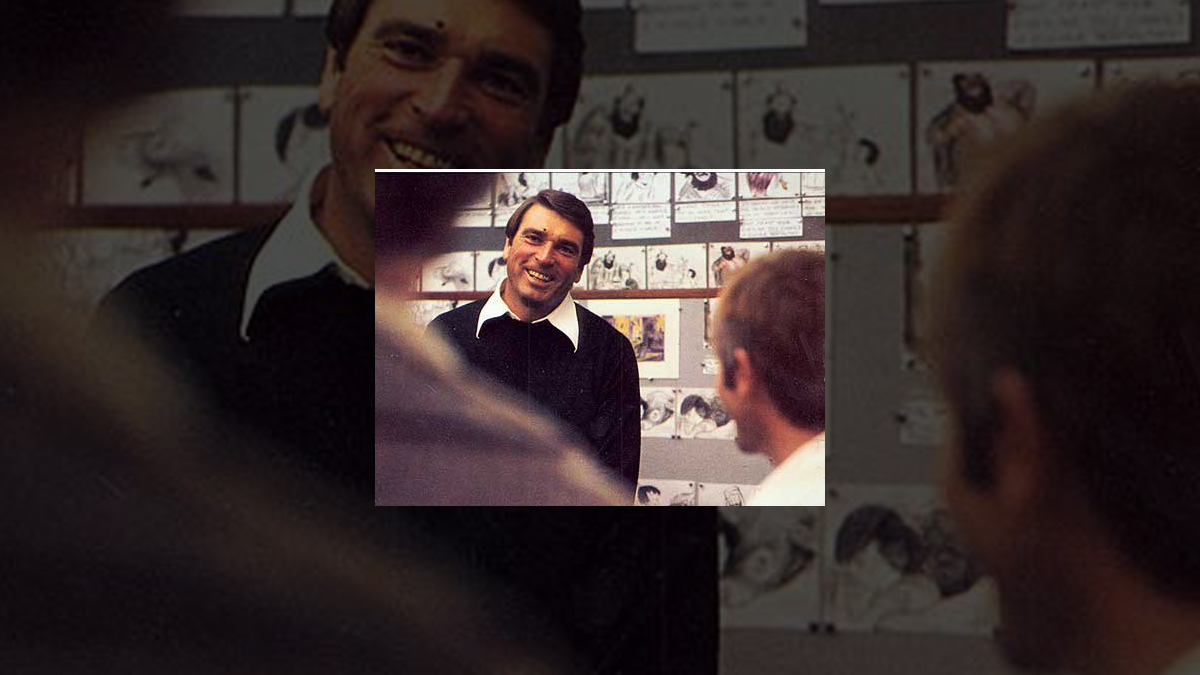
Without “TRON,” there wouldn’t be “TRON: Legacy,” and without former Disney CEO and producer Ron Miller, “TRON” may have never been made. Writer/director Steven Lisberger’s “TRON” project had been rejected by at least three other studios before he submitted it to Disney, hoping for the best but not really expecting the positive reaction he received.
Miller, Walt Disney’s son-in-law, is listed as executive producer of “TRON” and, if you’re in your 40s or older like me, you probably remember watching dozens of Disney movies that are part of the “RON: Legacy” – animated films like “The Rescuers,” “The Fox and the Hound” and “The Black Cauldron” as well as live-action films like “Never Cry Wolf,” “The Shaggy D.A.” “Tex,” “Freaky Friday” and many others. But the movies represent just a piece of Miller’s professional accomplishments.
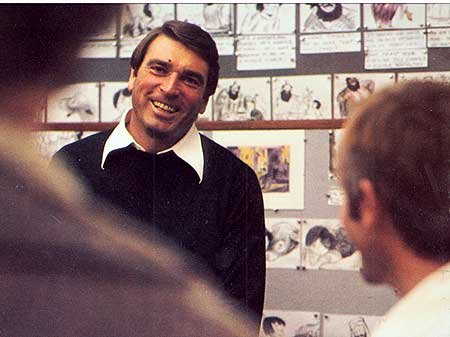
Ron Miller in the story room for “The Small One” back in 1976.
Copyright Disney Enterprises, Inc. All rights reserved
Miller started working on the Disneyland project in 1954, joined the Directors Guild in 1957 as a second assistant director on “Old Yeller,” and continued to advance in the company. By the time of Walt’s death in 1966, he was a key executive and part of the management team. It was Walt’s team that worked to complete both Walt Disney World and EPCOT in Florida. Miller became president of Walt Disney Productions in 1980 and was named as CEO in 1983, before being replaced by Michael Eisner and Frank Wells in 1984 in a move orchestrated by Walt’s nephew, Roy E. Disney. Miller was there when the company entered the home video market, launched its cable TV network, made its initial foray on Broadway and when it negotiated the deal for Tokyo Disneyland, the first Disney theme park outside of the United States.
Miller was also directly responsible for creating the “Touchstone” label to broaden Disney’s appeal beyond the G-rated films branded by Walt’s era.
As Walt’s son-in-law and Disney Company staffer, Miller had a unique professional and personal relationship with the creative genius. He directed several of Walt’s introductions to Disney’s weekly TV shows and watched as Grandpa Walt enjoyed time with his growing family.
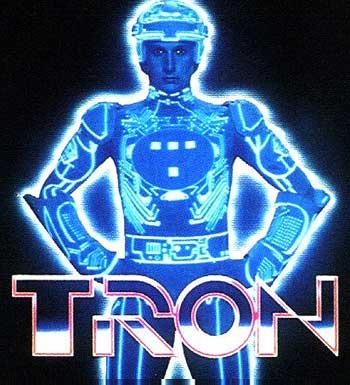
Copyright Disney Enterprises, Inc. All rights reserved
I recently spent a few minutes with Miller discussing “TRON” in advance of Disney’s huge reboot with “TRON: Legacy,” a film that’s been widely promoted at Comic-Con and elsewhere for nearly three years. “TRON: Legacy” opens Friday with expectations of a possible $1 billion worldwide box office gross.
In the case of 1982’s “TRON,” Miller says, he was the executive producer because “I was the individual who said ‘Let’s do it,’ ” based in part from a recommendation by a trusted Disney studio executive.
“God bless Tom Wilhite because he was the one who really took notice of it and felt very strongly that (‘TRON’) was something that time-wise was perfect for us. Which it was. Certainly it was something that we were looking for … it was something unique. It was an area that hadn’t really been explored before.”
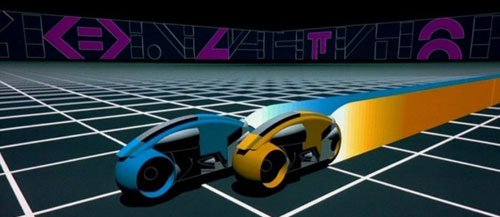
Copyright Disney Enterprises, Inc. All rights reserved
Still before committing to the production, the company had Lisberger complete a test scene to give Disney executives some idea of what “TRON” would look like.
“I would have to say that I was impressed with what I saw,” Miller said. “I think everybody embraced it because it was so intriguing. We realized that it was a big challenge. We realized that it was going to be very expensive, which it turned out to be. But it was a gamble worth taking.”
Wilhite would become the executive in charge of the production along with Lisberger’s colleague Donald Kushner. Disney’s Harrison Ellenshaw was tagged as the associate producer and praised Miller for his unyielding support of the project. You can hear a bit of Ellenshaw’s interview along with highlights of my interview with Miller at Paul Barrie’s latest WindowtotheMagic podcast …
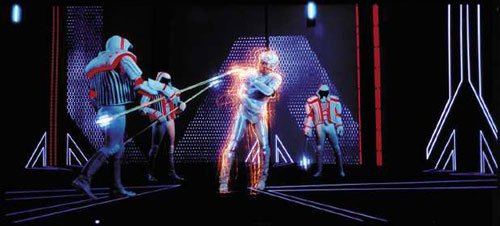
Copyright Disney Enterprises, Inc. All rights reserved
For “TRON,” Miller oversaw “some of the production, but the producer – certainly – is more involved than the executive producer.” Still, Miller says he approved the casting, visited the set, watched some of the dailies and kept finding the money as costs climbed.
I asked Miller if there was any point during the production that he considered pulling the plug on “TRON” or changing the approach on the film.
“Never,” Miller said. “Once we approved the story, once we approved the cast, once we approved all the special effects, it was go. And you don’t stop in the middle of the river and try to back pedal. You’ve got to go forward.”
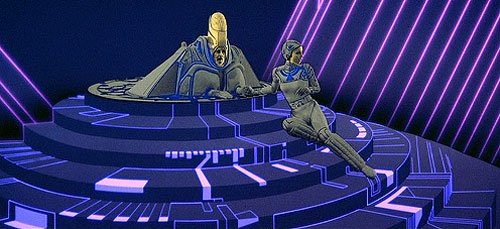
Copyright Disney Enterprises, Inc. All rights reserved
Still he admits, “TRON” was a “difficult picture to evaluate as it was being shot because the scene was not in front of you. You had all kinds of parts that came together that ultimately made the scene. But to sit through dailies – in my mind – was a little baffling. I didn’t quite understand what was going on.”
“TRON” reportedly cost about $17 million and grossed $33 million in its initial North American theatrical release. Worldwide box office figures were unavailable.
“I and a lot of other people were disappointed in the theatrical gross,” Miller admitted. “I think that the film should have done at least 50 percent better than what it did. I thought it was going to be a much bigger picture because its freshness and uniqueness and all that. But maybe we didn’t communicate what we had correctly, maybe we didn’t market it correctly. … We just missed the proper sales pitch on the film. I think people were a little bit confused with computer animation: What the hell is that, it was brand-new. Is it animation? Well, no. It’s not animation as you know it.”
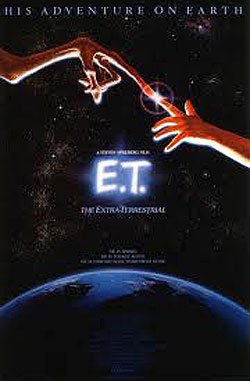
Copyright 1982 Universal Pictures.
All rights reserved
“TRON” came out at the same time as “E.T. – The Extra-Terrestrial,” which was in the cute-and-cuddly mode more common to Disney films. I asked Miller if he thought “E.T.” hurt “TRON” or if he thought that maybe audiences were more interested in outer space than cyberspace.
“I don’t think that one competed against the other. (They were) two totally different approaches to filmmaking,” he said. “When you’re up against (Steven) Spielberg, it’s tough. … I elude back to something that I said before, that unfortunately I just don’t think that we hit a home run with marketing and sales.”
Still, Miller says, he considers “TRON” an artistic and commercial success. The film was a huge hit when it was released on home video. He also knows the film proved to be important and inspirational to several filmmakers, including a young Disney animator, John Lasseter.
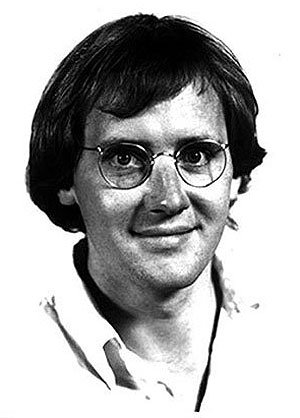
John Lasseter when he first began working for
Walt Disney Animation Studios. Copyright
1979 Walt Disney Productions.
All rights reserved
Lasseter has said that “Without “TRON,’ there would be no ‘Toy Story,’ ” even telling the former Disney CEO that directly years later.
While at Disney, Lasseter “used to poke his head in (‘TRON’) dailes and see what was happening,” Miller said. “He was very enamored with computer animation,” even pitching “The Brave Little Toaster” as a computer animated film before he was dismissed from the company.
“… Yeah, John was let go shortly after that, (but) I had absolutely nothing to do with it,” Miller said, wanting to set the record straight. Leslie Iwerks’ documentary film, “The Pixar Story,” said “that the CEO fired John. Well, I was the CEO and I would have never fired John,” he said. “No, I think that Ed Hansen – who was the production manager – had nothing more for John and that was it.”
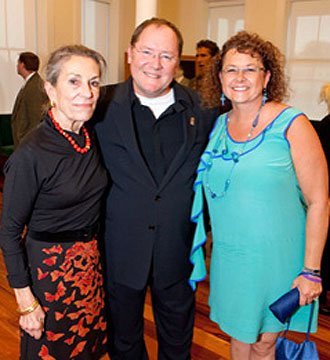
(L to R) Diane Disney Miller, John Lasseter and Nancy
Lasseter at the Walt Disney Family Museum’s opening
gala. Image courtesy of The Walt Disney Family
Museum. All rights reserved
Despite Lasseter’s dismissal, Ron and Diane Disney Miller share a good relationship with him and his wife, Nancy. Both families have wineries in the Napa Valley and they see each other a few times a year. Lasseter has been one of several current Disney employees who have been very supportive of the Walt Disney Family Museum at The Presidio of San Francisco.
“I like John a lot,” Miller says. “And we go all the way back to when Diane and I used to go to CalArts and there he was greeting us when we walked in. In fact, we thought that it was because of his affection towards Diane that he was there. But, we found out later, he was told to be there.”
I asked Miller if at the time when “TRON” was pitched to him, if he or his children, some of them in their teens, played video games.
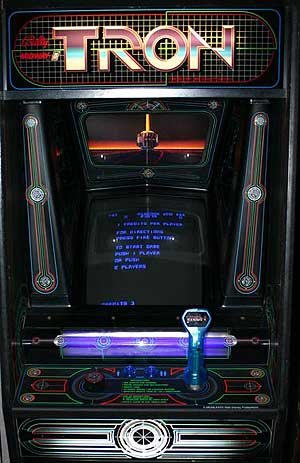
Copyright Disney Enterprises, Inc. All rights reserved
“… It’s about 28 years later and I still don’t play video games,” he said, laughing. “But we did have one in our house, the ‘TRON’ game. In fact, my youngest son, Patrick, became very efficient at it and he went to the – I think – sixth or seventh stage out of 10, which was amazing. I could get to the second stage. That was a very popular game out there. We sold a lot of them and I think my youngest son still has his.”
Miller also praised Disney’s decision a few months ago to pull the “TRON” DVD off retailers’ shelves with the new film coming out. “TRON” is reportedly being prepared for a Blu-ray release sometime in 2011.
“I think that it’s a fairly interesting move … I like it,” he said. “Let’s get (‘TRON’) off the shelves, let’s concentrate on (‘TRON: Legacy’). When people see this, they’ll want to see the original if they haven’t seen it already.”
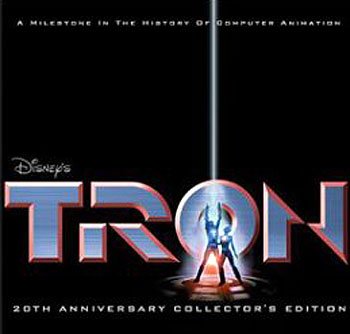
Copyright Disney Enterprises, Inc. All rights reserved
“TRON: Legacy” is certainly shining a blue laser light on Miller’s period at Disney and reminding people that he laid the foundation for several changes that helped fuel the growth of the company in the late ’80s and beyond. I asked him if he feels some vindication for what’s going on, that more people are taking a look at the things he accomplished that other people seem to have gotten credit for over the years?
“Oh, I don’t know,” he said, displaying a sense of modesty. “I think that Michael (Eisner) deserves the credit that he rightfully has. He brought a certain vitality to the company. The earnings every year went up and up and up. He hit some really big blockbusters early on. Though ‘Roger Rabbit,’ we were developing that …”
And, I interjected, “Splash” was yours.
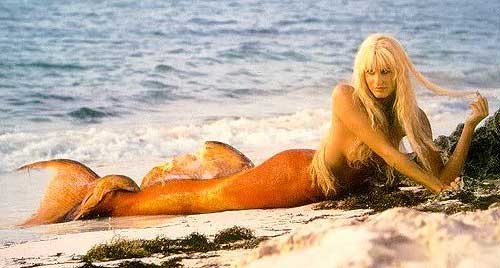
Copyright 1984 Touchstone Pictures. All rights reserved
“You know, ‘Splash’ is interesting. I told the gentleman from ‘Variety’ that it’s something that I lived with for a long time,” Miller said. “A G-rated film and you can’t go beyond that because what … are you going to do with the image that we have?”
Miller recalled watching “To Kill a Mockingbird” with Diane, Walt and Lilly in the projection room of Disney’s Holmby Hills home. When the film was over and the lights came on, Walt pounded his hand on the armrest of his chair and said “Damn, I wish I could make a film like that.” But Walt, Miller said, “was caught in his own web. He couldn’t broaden. He couldn’t go beyond what he had established as good Disney material or entertainment.”
Still Walt was most proud of “growing his company.” In multimedia clips at the Walt Disney Family Museum, you can hear him discussing branching out from the Mickey Mouse shorts to the Silly Symphonies, moving into full-length animated features, then tackling live-action films, TV and creating Disneyland. With every step forward, Walt was met with some nay-sayers.
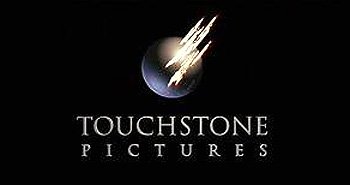
Copyright Touchstone Pictures, Inc. All rights reserved
“He always kept growing,” Miller said. “There was always a curiosity with the man: What was on the other side of the hill? And that’s what drove him. I mean, look, he was willing to drop motion pictures when he came out of the hospital, he had just had lung surgery, and he sat there and he said, ‘You know, I’ve got to concentrate on EPCOT. That’s the most important thing in the company’s future right now. And you guys have done a good job. So I’m confident that you can go out and make motion pictures and all. I’ve put a good team together.’ But my point being that his next project was EPCOT. And beyond that was another project. … He was fascinating in that way.”
I asked Miller if he simply was following Walt’s philosophy and trying to grow the company while he was CEO by doing things like creating Touchstone.
“But we had to … . The question became – do we continue making G-rated films which we had lost our younger audience because they wouldn’t be caught dead going into a G-rated film. So – I’ll never forget – it’s interesting that, with ‘Splash,’ I just hired Richard Berger. And somebody put ‘Splash’ on my desk and I read it and I liked it. And I also liked that it was connected with Ronnie Howard. You know, good chemistry.

Ron Howard and Tom Hanks take part in a “Splash” publicity shoot in
the Spring of 1984. Copyright Walt Disney Productions.
All rights reserved
“So I went to Berger and I said, ‘You know, Richard. I’ve got something here that I think we should consider. Because now I had made the decision to go with Touchstone. And he said ‘What is it?’ And I said that ‘It’s a Ronnie Howard project and it’s called ‘Splash.’ “
Berger told Miller that he turned “Splash” down when he was at 20th Century Fox. Miller had Berger reread the script and they made a decision to go forward with it.
Eventually Miller screened the film to about 3,500 people after a shareholders meeting at Walt Disney World. Miller warned them that “Splash” was not a G-rated film, that it was “a bit more mature, a little bit more adult.”
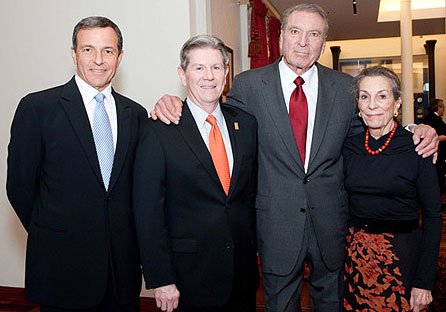
(L to R) Disney CEO Bob Iger, Walt Disney Family Museum executive director
Richard Benefield, Ron Miller and Diane Disney Miller. Image courtesy of
The Walt Disney Family Museum. All rights reserved
He told them that after the screening there would be a cocktail reception and he was going “to be there with all my armor on and everything else so you can take shots at me. And I sat through the showing of the film and you could tell that it was very well received,” Miller said. “And afterwards, we met later on and I think everyone except two people that came up to me and said ‘You’re on the right track.’ “
A few months later, Miller’s Hollywood career came to an abrupt end leaving only the “RON: Legacy.” But the Disney Company continues its global growth, even revisiting films from Miller’s era, such as “Freaky Friday,” “Escape to Witch Mountain,” “The Absent Minded Professor” and others.
And given that “TRON: Legacy” director Joseph Kosinski‘s next project for Walt Disney Studios may be a reimagining of another Miller era sci-fi adventure, “The Black Hole ” …
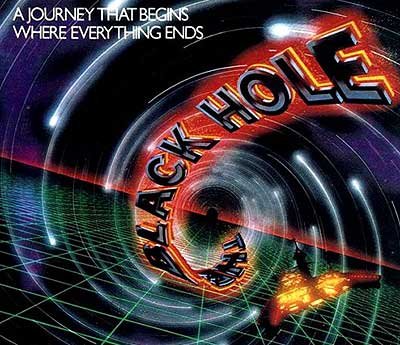
Copyright 1979 Walt Disney Productions. All rights reserved
it looks like we’re far from the “end of (the) line” when it comes to the “RON: Legacy.”
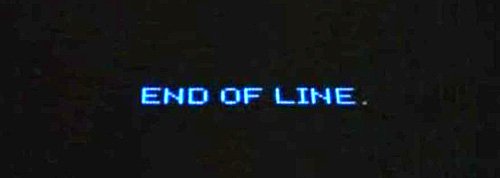
Copyright 1982 Walt Disney Productions. All rights reserved
Your thoughts?
If you’re still looking for that perfect gift for Grandma, Aunt Pat or Uncle Earle please
click on the banner below. If you do that … well, JimHillMedia.com then gets a teeny,
tiny chunk of whatever you spend at Amazon.com
Thanks and Happy Holidays!
Events
From toxic gas leaks to the triumph of ‘Finding Dory,’ Lindsey Collins has loved every minute of her time at Pixar Animation Studios

When it comes to “Finding Dory” producer Lindsey Collins, she takes “going-with-your-gut” to a whole new level.
To explain: This Occidental College graduate joined Walt Disney Animation Studios straight out of school in 1994. And after working as a PA on “Pocahontas” & “The Hunchback of Notre Dame,” Lindsey had just been made assistant production manager on “Hercules” when she began hearing people talk about Pixar.
“I was working at Disney with Ron & John (Author’s note: That’s Ron Clements & John Musker, the acclaimed animation directing team behind not only “Hercules” but also “The Little Mermaid,” “Aladdin” and WDAS’ soon-to-be-released “Moana”) and was really enjoying that experience. But just before ‘Toy Story’ came out, there was a brief blurb in the company newsletter about Pixar. And I was like ‘Well, who are these guys?’ And then I got to meet John Lasseter and was just totally blown away by what he and his team were doing,” Collins recalled during a recent phone interview.
 Lindsey Collins. Copyright Disney Pixar
Lindsey Collins. Copyright Disney Pixar
“Anyway, Disney liked what I was doing at Feature Animation and really wanted me to stay on there. So they offered me a contract. And I was like ‘I’m fine. I can stay here.’ So I signed that contract. And then I went home and threw up all night,” Lindsey laughed. “The very next day, I went back into Disney and said ‘I’m sorry. I can’t do this. I really have to go.’ Then I went up to the Bay area and basically pounded on Pixar’s door & said ‘please, please, please hire me.’ “
Luckily for Ms. Collins, Pixar Animation Studios was just in the process of gearing up to do “A Bug’s Life.” More to the point, Sharon Calahan – the director of photography on that production – saw lots of potential in this recent Mouse House escapee.
“Sharon was hugely involved with Pixar’s decision to hire me. And part of that was because I had worked with background painters while I was at Disney Feature Animation. So even though I had no clue how CG worked at that time, I could talk with Sharon in the terms of painting. And she was like ‘That’s exactly how I want people around here to start thinking when it comes to how we light our scenes,’ ” Collins continued.
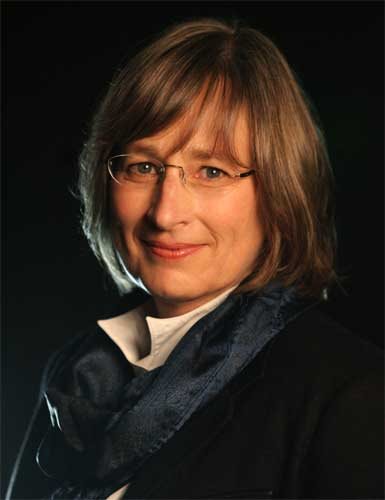 Sharon Calahan. Copyright Disney Pixar
Sharon Calahan. Copyright Disney Pixar
“Mind you, I was the one who kept telling Sharon ‘I don’t know how helpful I can be to you guys. Because I really don’t understand a lot of what you’re saying when it comes to CG.’ But she wouldn’t give up on me. Sharon kept insisting that – because I had already worked with artists and knew how to communicate a vision for a painting – I was also going to be able to communicate with software engineers. It was just a matter of learning a new language. Sharon was instrumental in convincing me that I had any right to be at Pixar,” Lindsey stated.
Which isn’t to say that life was initially easy for Collins at Pixar. First there was that steep learning curve which came with her new job (“When I first got here, I had no idea what a render farm was. I was like ‘There’s a farm? Like a petting zoo?’ “). Then there was the fact that the Port Richmond office park which housed this animation studio at that time was downwind of a Chevron plant (“Sometimes – because there’d be explosions or gas leaks at that plant — we’d then be told to shelter in place or to not come into work at all that day. We used to call those toxic snow days”).
But even under these somewhat stressful & occasionally toxic conditions, Lindsey thrived. Largely because she really loved her new co-workers at Pixar (“They were people who could really make me laugh. In a way I didn’t know that real adults / professionals could make me laugh. And I feel like I haven’t stopped since I got here”).
 Copyright Disney Pixar
Copyright Disney Pixar
But it hasn’t all been big laughs. Take – for example – what happened when Ed Catmull, the president of Pixar Animation Studios, approached Collins (who was producing “Finding Dory” at that time) about a change that he wanted to make to that Andrew Stanton film.
“Pixar had this new renderer that it wanted to try out. And Ed felt ‘Dory’ would be the perfect project to try this new technology on. The only problem was that – when Ed approached me – we were already well into production on this ‘Finding Nemo’ sequel. Which meant – if we were going to take full advantage of what Ed was offering us – we’d then have go back and redo a bunch of stuff we’d already done on this movie,” Lindsey said.
“But the good news was – because “Dory” was a sequel to “Nemo” – we weren’t discovering a look for this movie. We were just trying to improve on it,” Collins continued. “And that was the handshake deal that Ed was offering. That – if we agreed to use this new renderer plus some new lighting & shading tools. Basically reinventing the entire back end of the Pixar production line – we’d then end up with a far better looking film that was still set in the same world as ‘Nemo.’ As long as the studio delivered on that promise, Andrew was willing to go for it. Mind you, it would be another full year before Andrew would then actually get to see any footage that this new renderer produced. So it was a huge leap-of-faith on his part. But Andrew was incredibly excited when the redone ‘Dory’ footage began coming in and it all looked so great.”
 Copyright Disney Pixar
Copyright Disney Pixar
Another technology challenge that Lindsey had to deal with while producing this “Finding Nemo” sequel was Hank the septopus. But in this case, as soon as Collins saw this character described in an early draft of Stanton’s ‘Dory’ script, she immediately got Pixar’s character department involved.
“When you’re working as a producer, you get to see pages a lot earlier than the rest of the crew. And as soon as I read that first scene with Hank, I turned to Andrew and said ‘Just how big a character are we talking here?’ And he said ‘I think it’s a pretty big role.’ And I was like ‘Okay.’ And I then went down to the character department and told them that Andrew wanted to add an octopus to the cast. And they all went kind of pale,” Lindsey said. “I think what they knew right-off-the-bat that – if we were going to do an octopus in the ‘Nemo’ / ‘Dory’ world with all of the realism & beauty that entails and then have that character fit in – it was going to be incredibly difficult if not kind of impossible to pull that off. Largely because the character of Hank couldn’t be super-cartoony.”
“I mean, on ‘Finding Nemo,’ we had had Pearl, the little octopus who was in Mr. Ray’s class. But clearly the whole point of a character like Hank was that he needed to be a jack-of-all-trades. That this character was going to have to be able to get in & out of everything. So the character department knew – right off the bat – that this was going to be something that would kind of break the bank, if you will,” Collins continued.
 Copyright Disney Pixar
Copyright Disney Pixar
“Now what you have to understand about Pixar is that we play ‘Chicken’ a lot here. By that I mean, we see how long we can let something sit on the page before we then have to finally move it into production. But when it came to Hank, that just wasn’t an option,” Lindsey stated. “Based on this character’s needs, Hank was going to take every minute we had, all the time between when he first appeared in Andrew’s script and when we’d be in full production on ‘Dory’ to build this. So we needed to commit very early on this character. But the good news is that I think we bet right on Hank. He actually wound up being a far bigger character in this film. And I think that was partially because the technology which drove this character was so cool.”
So how did it feel – after five years of hard work – to have “Finding Dory” become this hugely popular motion picture? The fifth animated film in all of Hollywood history to earn over a billion dollars at the worldwide box office? Collins – the mother of three – put a somewhat maternal spin on her reply.
“You have to understand that – when you work on projects like ‘Dory’ or ‘John Carter’ for as long as Andrew and I did – these movies are kind of like your kids. In that they then go off & have their own successes & failures which are kind of beyond your control as a parent,” Lindsey said. “But as you’re finishing up working on a film, emotions do sometimes well up at the weirdest time.”
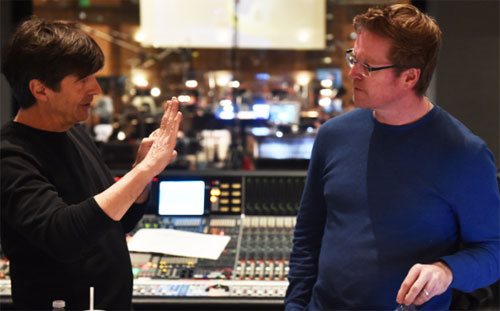 Thomas Newman (L) and Andrew Stanton in the booth during the recording sessions for “Finding Dory” ‘s score. Copyright Disney Pixar
Thomas Newman (L) and Andrew Stanton in the booth during the recording sessions for “Finding Dory” ‘s score. Copyright Disney Pixar
Take – for example – what happened while Collins & Stanton were sitting in the recording booth as Thomas Newman rode herd on “Finding Dory” ‘s scoring sessions.
“We’d had this huge orchestra for four days. And then – on the last day – Tom cleared the stage and recorded the scene where Nemo, Marlin & Dory reunite in the pipes under the Marine Life Center. Now you have to understand that this is one of the only times in his score for ‘Finding Dory’ that Tom reprises a cue from “Finding Nemo.’ And he has this single clarinet – or was it an oboe? – play that cue,” Lindsey recalled. “And as this was happening, Andrew got really quiet. He was just sitting there, watching.”
“So I went up to him and said ‘What’s going on? How are you feeling about all this?’ Because we were finishing this film up at that time. And Andrew looked at me and he was really emotional. And then he said “I remember the first time I wrote Dory’s name on a piece of paper. I can’t believe how far she’s come.’ And that’s when I started getting emotional too, ” Collins said.
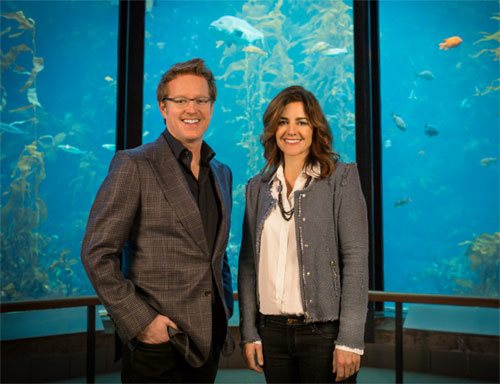 Andrew Stanton & Lindsey Collins. Copyright Disney Pixar
Andrew Stanton & Lindsey Collins. Copyright Disney Pixar
And speaking of ” … how far she’s come,” one might say the same thing about Lindsey. Who – it should be noted here – when she was studying at Occidental College 25 years ago, didn’t major in business or film studies. But – rather – diplomacy and world affairs.
“Those diplomacy skills do actually come in handy when you’re working on a movie. But you want to honestly know the very best thing you can do at college if you eventually hope to become a producer? Work as an RA,” Collins concluded. “Katherine Sarafian – who’s also a producer here at Pixar — also ran a dorm while she was in college. And the two of us agree that that job was great training for becoming a producer. When you’re constantly dealing with people and have to get answers to ridiculous questions like ‘Okay, who pooped in the closet?’ “
The Blu-ray & DVD version of Pixar’s “Finding Dory” hits store shelves today.
This article was originally published by the Huffington Post on Tuesday, November 15, 2016
Events
Women in Animation panels prove that there’s more to San Diego Comic-Con than just promotion of pop culture
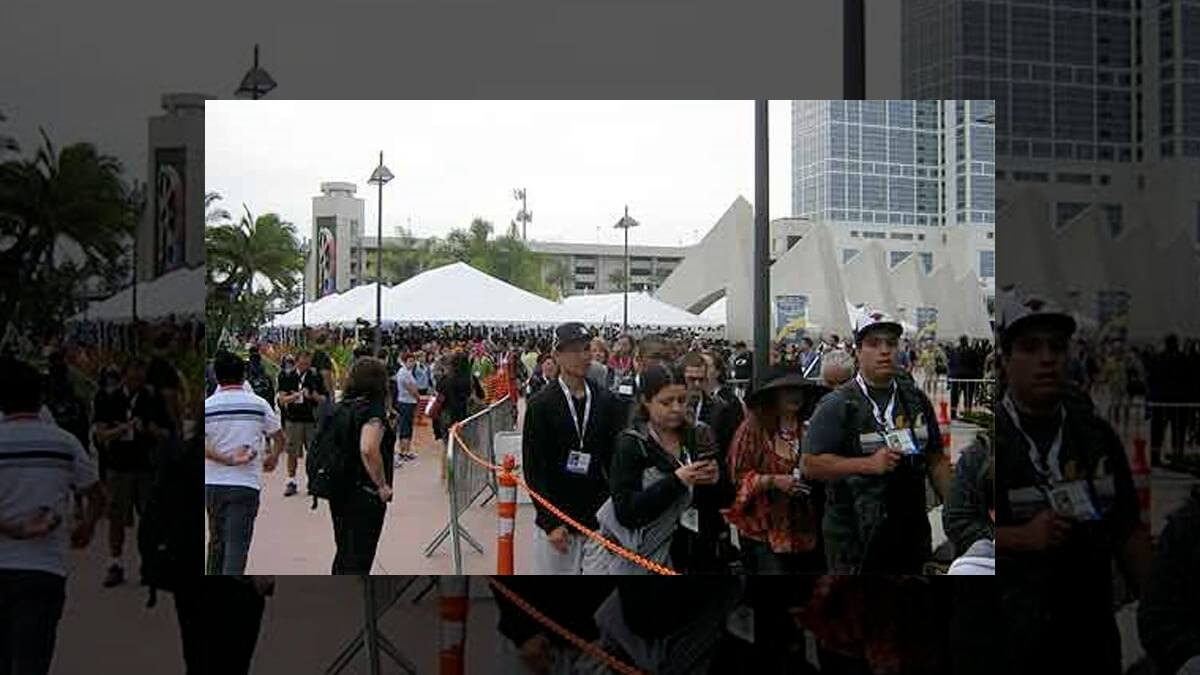
Thanks to Comic-Con International, now through Sunday, San
Diego is the white-hot center of the pop culture universe.

Photo by Jim Hill
Mind you, there’s more to this four day-long event than
those high-profile presentations in Hall H. Which is where various movie
studios will be parading celebrities & showing exclusive clips. All with
the hope that those 6000 early adopters who have (some of them, anyway) been
camped out in this cavernous convention center for hours ahead of time will
then hop on social media and start evangelizing about how cool that footage
from next summer’s would-be blockbuster looked.
But if you can look past those long lines for
limited-edition merchandise and/or the tens of thousands of people who are
cosplaying, you’ll see that there’s another, more serious side to Comic-Con
International. And that’s the part of this four day-long event which allows a lot
of creatives to reconnect with one another.
Take – for example – Marge Dean, the general manager of
Stoopid Buddy Stoodios (i.e., that Burbank-based operation which is responsible
for “Robot Chicken,” television’s longest-running stop motion series, as well
as Sony’s just-about-to-begin-production-on-its-second-season-for-Crackle
superhero spoof, “SuperMansion”). Over the past decade, she’s made at least
eight trips down to San Diego for Comic-Con International. And what Marge loves
most about this four day-long event is all of the old friends she invariably
runs into as she’s coming & going from the convention center.

Photo by Jim Hill
“Whenever I’m down in San Diego for Comic-Con, I just love
the experience of getting outside the hall, walking down the street and then
suddenly going ‘It’s you ! A guy I haven’t seen in three years ! How are you
!,” Dean recalled during a recent phone interview. “Even though I really don’t
like driving to Comic-Con – which is why, these days, I always take the train
down from LA – I really enjoy strolling around San Diego and then running into
people that I haven’t seen for a long, long time.”
Mind you, Marge is sure to run into a lot of people that she
knows / has previously worked with today in Room 24ABC at the San Diego
Convention Center. That’s because this is where Comic-Con’s “Cartoon Creatives:
Women Power in Animation” panel will be held starting at 4:30 p.m. PT. And
joining Dean at this gathering (which will be shining a spotlight on Women in
Animation‘s goal to have a 50/50 workforce by 2025) will be a veritable who’s
who from the worlds of television & feature animation.
Among those who are scheduled to appear today are:

Daron Nefcy, the creator / executive producer of “Star vs. the Forces of Evil.”
Copyright Disney Enterprises, Inc. All rights reserved
-
Lauren Faust (the creator of “My Little Pony:
Friendship is Magic”) -
Brooke Keesling (the director of animation
talent development at Disney TV Animation) -
Katie Krentz (the senior director of development
at Cartoon Network) -
Lauren Montgomery (the co-executive producer of
“Voltron: Legendary Defender”) -
Daron Nefcy (the creator / executive producer of
“Star vs. the Forces of Evil”) -
Gina Shay (the producer of DreamWorks
Animation’s “Trolls”) -
Stevie Wermers-Skelton (the co-director of
Disney’s upcoming “Frozen” holiday special)
Dean (who serves as the co-president of WIA) views this
hour-long session (which will be moderated by Leslie Combemale of Animation
Scoop) as a great example of a lesser known aspect of Comic-Con International.
Which is the many ways that this four day-long event educates the fan
community. Gives them a clearer understanding of what’s really going on in
today’s entertainment world.

Marge Dean, co-president of Women in Animation, speaking at a WIA event
honoring Nickelodeon’s contributions to television animation.
“I mean, did you know that women hold only 20% of the
creative roles in today’s animation industry? While the landscape has obviously
changed over the 20+ years that I’ve worked in this field, women still predominantly
work on the management side of animation. Not the creative end of things,”
Marge continued. “That’s a big part of what the Women in Animation organization
is all about. More to the point, why we’re doing outreach to the fan community
at Comic-Con this week. We’re looking to shine a spotlight on this disparity in
the industry and hopefully create some opportunities for more women to break
through creatively in the future.”
Of course, in order to know where you are (more importantly,
where you’re headed next), it helps to have to have a firm understanding of
where you’ve been. Which is why WIA will be holding a second panel at Comic-Con
International, “She Made That? Nickelodeon hosts Women in Animation.” This
presentation (which will also be held in Room 24ABC from 6:30 – 7:30 p.m. PT on
Friday, July 22nd) will honor some of the real pioneers of
television animation. The women who helped create such memorable Nicktoon
series as:
-
Vanessa Coffey (“The Ren & Stimpy Show,”
“Rugrats” & “Doug”) - Mary Harrington (“Invader Zim,” “Hey Arnold!”)

Television animation pioneer Margaret Loesch
Of course, Coffey was quick to credit the woman who gave her
a leg up when she was just getting her start in animation in the early 1980s.
And that was Margaret Loesch, the then-President and CEO of Marvel Productions.
“At that time, Margaret was the only woman working in
television animation. I was just this intern, working down the hall from Stan
Lee. But Margaret took a chance on me,” Vanessa remembered. “And Margaret not
only mentored me, she genuinely inspired me. I mean, here she was running this
huge production company in a field that was mostly run by men. Margaret proved to
me that not only should women in the animation business but that they could be
these huge successes.”
You see? That’s what’s really great about Comic-Con
International. If you can just get past all of the hype (not to mention handle those
super-crowded conditions you’ll encounter out on the show floor), you might
then discover that some real education has been mixed in with your
entertainment.

(L to R) Vanessa Coffey, Stephen
Hillenburg (the creator of
“SpongeBob SquarePants”) and and Butch Hartman (the
creator of “The Fairly Oddparents.”
Comic-Con International is running at the San Diego
Convention Center now through Sunday, July 24th.
This article was originally posted on the Huffington Post’s Entertainment page on Thursday, July 21, 2016.
Books & Print
It’s Jim Hill in the Restaurant with the Book – The Jungle Book – and You Can Join Him June 5th

It’s a Jungle (Book) Out There

For more than 50 years, The Walt Disney Company has been reimagining the writings of Rudyard Kipling–taking his tales of Mowgli the man-cub and his animal friends and then turning them into hugely popular films and television series.

Let Jim Hill take you from Bill Peet’s far-too-dark take on this tale (which Walt Disney just hated) to Jon Favreau’s photo-realistic box office smash (for which the Studio is already developing a sequel).
You’re sure to go ape as you listen to all of these great behind-the-scenes show business stories.
Join us June 5th, 2016 from 11:30 AM-1:30 PM at HB Burger, 127 West 43rd Street in New York City
Tickets are $62.00: Each ticket includes lunch at HB Burger, the program, and a special souvenir.
Buy tickets now on line here –> Unofficial Guide’s Disney Dish site or here –> e.t.c. (events — tailor made & customized)
Get your tickets now!
email events@etccustomevents.com with any additional questions.
-

 Film & Movies8 months ago
Film & Movies8 months agoBefore He Was 626: The Surprisingly Dark Origins of Disney’s Stitch
-

 History6 months ago
History6 months agoCalifornia Misadventure
-

 History11 months ago
History11 months agoThe Super Bowl & Disney: The Untold Story Behind ‘I’m Going to Disneyland!’
-

 Film & Movies7 months ago
Film & Movies7 months agoThe Best Disney Animation Film Never Made – “Chanticleer”
-

 Television & Shows12 months ago
Television & Shows12 months agoHow the Creators of South Park Tricked A-List Celebrities to Roast Universal – “Your Studio & You”
-

 Theme Parks & Themed Entertainment6 months ago
Theme Parks & Themed Entertainment6 months agoThe ExtraTERRORestrial Files
-

 Television & Shows9 months ago
Television & Shows9 months agoThe Untold Story of Super Soap Weekend at Disney-MGM Studios: How Daytime TV Took Over the Parks
-

 History7 months ago
History7 months agoWhy Disney’s Animal Kingdom’s Beastly Kingdom Was Never Built






